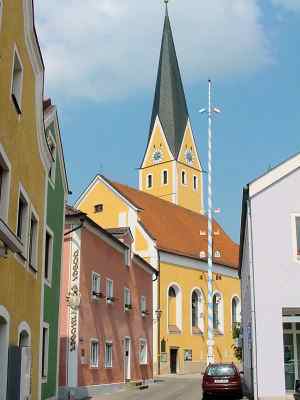
The Parish Church of St. Aegidius
in Dietfurt in the national park Altmuehl valley
In about A.D. 1400 the original church of Dietfurt must have been replaced by the Gothic church of St. Aegidius. A number of donations, documented in the years around 1400, suggest this assumption. Apparently the construction was finished in 1408, because after 1408 documents speak of the St. Aegidius Church Dietfurt; before that date it is just the "church of Dietfurt".
Old engravings and reports of visitation can give us an idea of what the old church looked like. The building was much lower and shorter than it is now. Of the old church only the slim tower, 180 feet high, has been preserved. Formerly the vestry was in its ground floor. The Gothic church had seven altars, four of them in the aisles the others in side chapels.
In the 18th century the building decayed substantially; repair works were often necessary and cost a lot of money. In 1730 the council of Dietfurt stated that the parish church was so delapidated that snow and rain penetrated the roof and that the roof supports were going to collapse.
The bishop of Eichstaett ![]() was obliged to maintain the building, and the council asked him to grant the means for a new and larger church. In 1732 the bishop´s chief architect himself, Gabriel de Gabrieli, travelled to Dietfurt and examined the building. The architect ascertained dilapidation and too small windows. He advised that the nave should be made longer and higher, the windows be enlarged and the roof be reconstructed. Plans were submitted, the bishop consented, and the same year reconstruction work began, supervised by Domenico Barbieri, another famous Italian builder.
was obliged to maintain the building, and the council asked him to grant the means for a new and larger church. In 1732 the bishop´s chief architect himself, Gabriel de Gabrieli, travelled to Dietfurt and examined the building. The architect ascertained dilapidation and too small windows. He advised that the nave should be made longer and higher, the windows be enlarged and the roof be reconstructed. Plans were submitted, the bishop consented, and the same year reconstruction work began, supervised by Domenico Barbieri, another famous Italian builder.
Roof and roof supports were pulled down. The walls were left standing - that is why we can now see Gothic frescoes and a Gothic porch. Length and form of the choir were not altered, nave but the was made longer by eleven feet. The walls of the aisles were raised by seven feet.
After two years brickwork was finished, and in 1736 the interior equipment was making so much progress that the suffragan bishop consecrated the church.
In 1807 a thorough outside renovation was necessary. Instead of repairing them, workers knocked off the mouldings on the western facade, for there was not enough money. A tinplate roof was provided for the spire.
Wideness and brightness of the aisles are surprising. There are vaults and pilaster-strips. The frescoes were painted by an unknown artist. In one of the large frescoes Christ the Healer is depicted, the other shows St. Aegidius, the patron saint of the church. There is an old view of the town with the burgomaster sacrificing the hearts of the burghers and praying: Protect town and land! The smaller frescoes show scenes from the life of the saint. The pictures in the choir, laid bare in 1964, differ considerably from the ceiling frescoes; they show the coronation of the Holy Virgin and emblems of the Holy Trinity.
The mighty high altar was built by Bochler in 1737. The four big statues of saints were installed later. The large painting comes from the old church and shows St.Aegidius in his hermitage. There are many more works of art in the parish church: tabernacle, worshipping angels, side altars, pulpit, font, lectern, carved pews, a very fine pieta and a madonna on the crescent moon with flying angels.
back to the Homepage of the town Dietfurt ![]()
Zuletzt aktualisiert am 10.02.2017